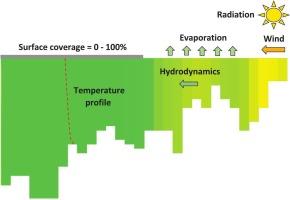地表覆盖对热带浅层水库蒸发和水动力影响的二维模拟
IF 6.3
1区 地球科学
Q1 ENGINEERING, CIVIL
引用次数: 0
摘要
长期以来,人们一直在研究物理、化学和/或生物覆盖物对减少水箱、池塘和自然水体蒸发的影响。然而,人们对这种装置对水库流体动力学的影响知之甚少,特别是在热带地区观察到的高度变化的流入条件下。本研究采用二维模型(ce - quality - w2)模拟了0 ~ 100%的地表覆盖度(SC)对巴西福塔莱萨热带浅层水库蒸发和水动力学的影响,该水库年际和季节入水量变化较大。我们还测试了广告投放和广告类型的影响。与以往的研究相比,该模型很好地反映了蒸发量的年际和季节变化,以及SC的影响。提出了无量纲相关性来预测SC对减少蒸发(高达91%)、表面温度(高达17%)和水平速度(高达26%)的影响。由于地表覆盖(SC)从零(SC = 0)到全覆盖(SC = 100%)不等,从湿润期到干燥期,蒸发量的季节变化从增加25%到减少26%不等。结果还表明,由于温度和水平速度的降低,停留时间(RT)随SC的增加而增加(可达19%)。还获得了将RT与SC联系起来的无量纲相关性。此外,SC对RT的影响从潮湿到干燥年份增加(高达16%)。最后,结果表明,与其他表面覆盖位置和类型相比,较浅深度的部分SC减少了蒸发量(高达6%)。本研究提出的二维建模方法和无量纲相关性不仅提高了对浅层水库蒸发和水动力学的认识,而且是预测物理、化学和/或生物屏障对这类生态系统水平衡和水质的潜在影响的实用工具。本文章由计算机程序翻译,如有差异,请以英文原文为准。

Two-dimensional modeling of the impact of surface coverage on the evaporation and hydrodynamics of a shallow tropical reservoir
The effect of physical, chemical and/or biological covers on the reduction of evaporation in tanks, ponds and natural water bodies has long been studied. However, little is known about the impact of such devices on the hydrodynamics of reservoirs, specially under highly variable inflow conditions, as observed in tropical regions. The present study applied a two-dimensional model (CE-QUAL-W2) for simulating the impact of surface coverage (SC) from 0 to 100 % on the evaporation and hydrodynamics of a shallow tropical reservoir located in Fortaleza, Brazil, characterized by a high interannual and seasonal inflow variability. The effect of the placement and type of coverage was also tested. The model represented well the interannual and seasonal variations in evaporation, as well as the impact of SC, as compared to previous studies. Dimensionless correlations were proposed to predict the effect of SC on the reduction of evaporation (up to 91 %), surface temperature (up to 17 %) and horizontal velocity (up to 26 %). Seasonal variations in evaporation from the wet to the dry period ranged from an increase of 25 % to a decrease of 26 %, as surface coverage (SC) varied from zero (SC = 0) to full coverage (SC = 100 %). The results also indicated that the residence time (RT) increased with SC (up to 19 %) due to reduced temperature and horizontal velocity. A dimensionless correlation was also obtained to relate RT to SC. Additionally, the impact of SC on RT increased from wet to dry years (up to 16 %). Finally, the results showed that partial SC at shallower depths reduced evaporation (up to 6 %) compared to the other cases of surface cover placement and type. The 2D modeling approach and dimensionless correlations proposed in the present study not only advanced in the knowledge of evaporation and hydrodynamics of shallow reservoirs, but also serve as a practical tool to predict the potential impacts of physical, chemical and/or biological barriers on the water balance and water quality of such ecosystems.
求助全文
通过发布文献求助,成功后即可免费获取论文全文。
去求助
来源期刊

Journal of Hydrology
地学-地球科学综合
CiteScore
11.00
自引率
12.50%
发文量
1309
审稿时长
7.5 months
期刊介绍:
The Journal of Hydrology publishes original research papers and comprehensive reviews in all the subfields of the hydrological sciences including water based management and policy issues that impact on economics and society. These comprise, but are not limited to the physical, chemical, biogeochemical, stochastic and systems aspects of surface and groundwater hydrology, hydrometeorology and hydrogeology. Relevant topics incorporating the insights and methodologies of disciplines such as climatology, water resource systems, hydraulics, agrohydrology, geomorphology, soil science, instrumentation and remote sensing, civil and environmental engineering are included. Social science perspectives on hydrological problems such as resource and ecological economics, environmental sociology, psychology and behavioural science, management and policy analysis are also invited. Multi-and interdisciplinary analyses of hydrological problems are within scope. The science published in the Journal of Hydrology is relevant to catchment scales rather than exclusively to a local scale or site.
 求助内容:
求助内容: 应助结果提醒方式:
应助结果提醒方式:


